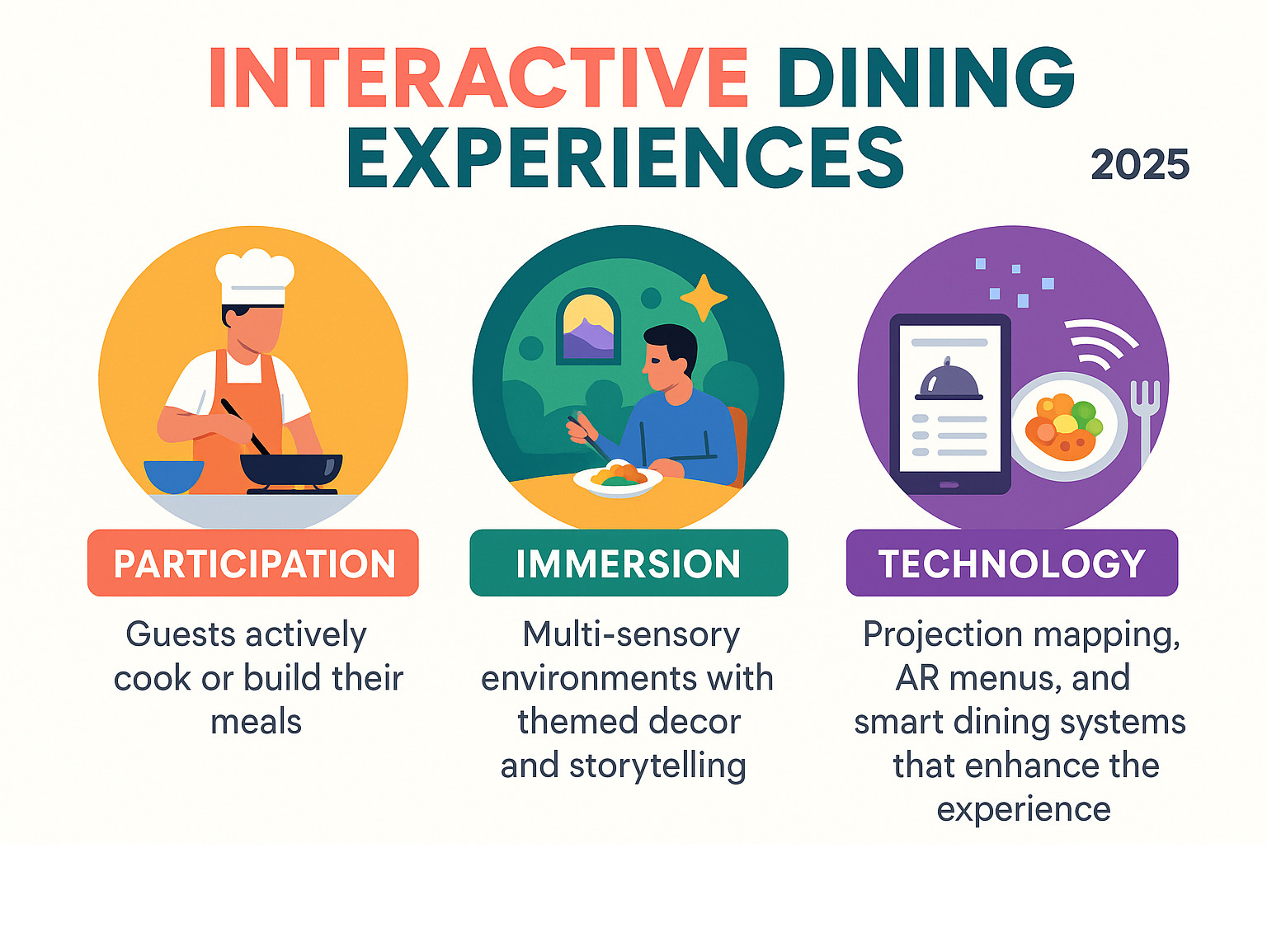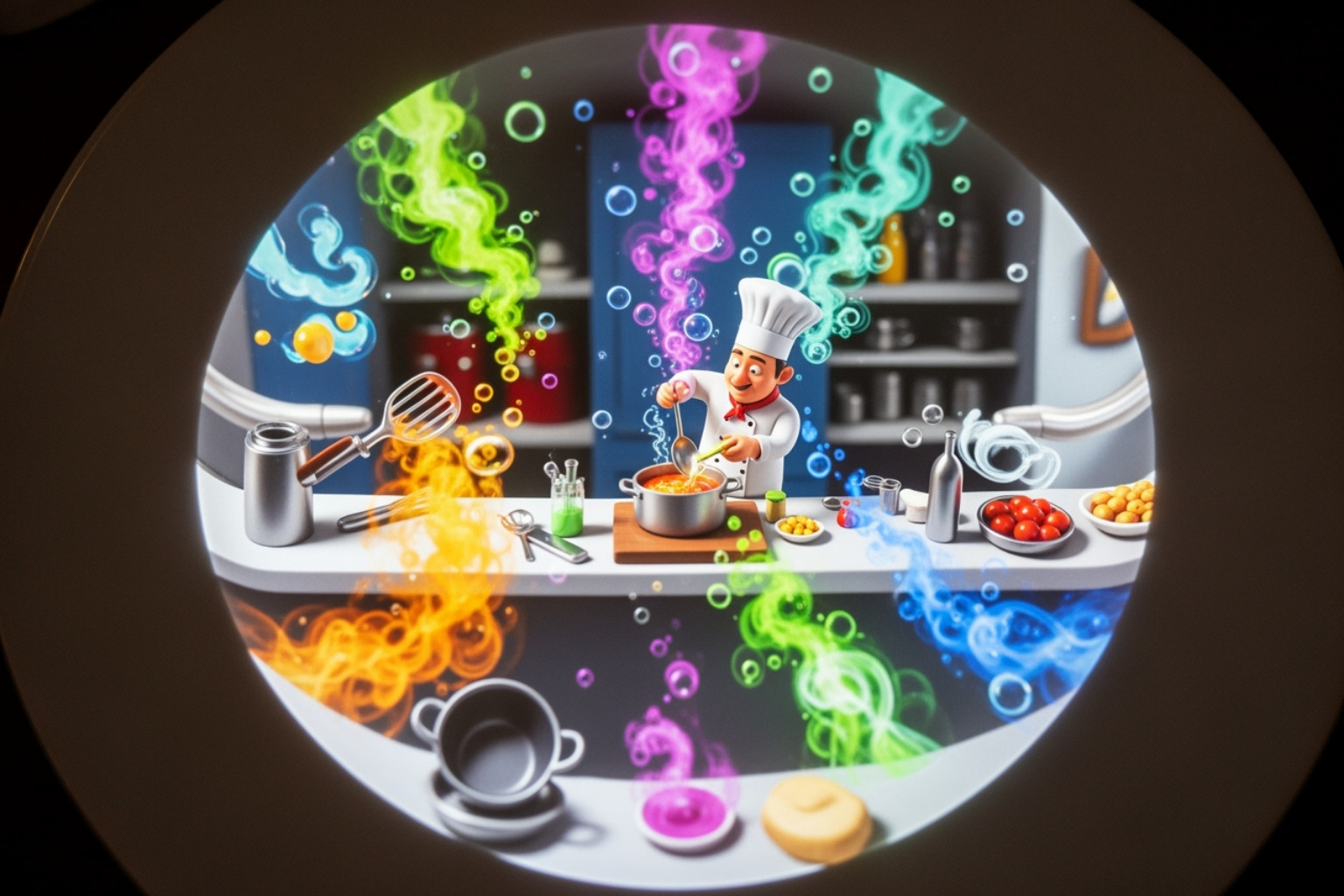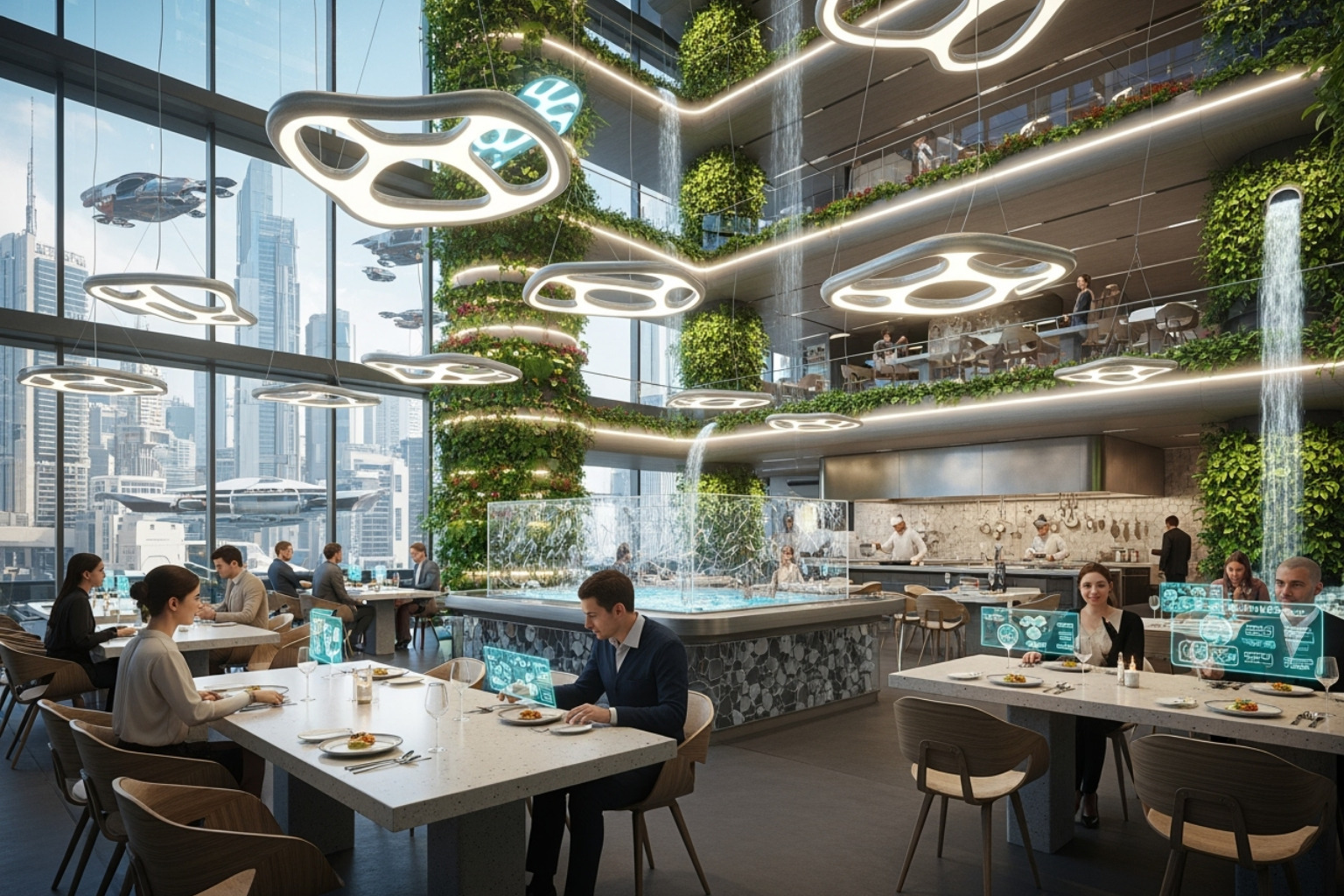Why Interactive Dining Experiences Are Changing How We Eat
Interactive dining experiences turn ordinary meals into memorable trips where you become part of the show. Instead of simply ordering and eating, you participate in cooking, storytelling, or immersive environments that engage all your senses.
What defines an interactive dining experience:
- Active participation – cooking your own food, building dishes, or engaging with chefs
- Multi-sensory elements – projection mapping, themed environments, curated sounds and scents
- Storytelling components – narrative-driven meals with theatrical presentations
- Technology integration – AR menus, smart tables, or immersive visual displays
- Social engagement – shared cooking experiences that encourage connection
Today’s diners, especially Gen Z and millennials, value experiences over material possessions. The research shows that 87% of diners visit restaurants they finded on social media, proving that shareable, Instagram-worthy moments drive dining decisions.
This shift reflects a broader change in how we think about food. Dining is no longer just about satisfying hunger – it’s about creating lasting memories and connecting with others in meaningful ways.
As one industry expert puts it: “Food brings people together. Nothing rings truer than that statement.” This philosophy drives the growing popularity of interactive formats, from Korean BBQ grills where you cook at your table to immersive dinner shows featuring projection-mapped storytelling.
The experience economy has reached the restaurant industry, changing meals into entertainment that engages your imagination and creates stories worth sharing.

Basic Interactive dining experiences vocab:
What Makes a Dining Experience Truly Interactive?
The magic of interactive dining experiences lies in changing you from a passive observer into an active participant in your culinary journey. Instead of simply sitting back while food appears at your table, you become part of the story, engaging with your meal on multiple levels.
True interactivity engages all your senses and emotions. Picture the sizzle of meat hitting a hot grill at your Korean BBQ table, the theatrical flair of a teppanyaki chef flipping shrimp into his hat, or the wonder of watching a tiny projected chef “prepare” your meal right on your plate. These moments create connections – between you and your food, you and your dining companions, and you and the culinary team bringing it all to life.
What makes these experiences so appealing is how they address modern dining desires. Today’s diners, especially younger generations, crave authenticity and participation. They want to feel empowered in their choices and create memories worth sharing on social media.
The Power of Participation
When you roll up your sleeves and get involved in preparing your meal, something wonderful happens – the food tastes better because you had a hand in creating it. This hands-on approach also tackles a surprising modern problem: menu anxiety, which affects 86% of Gen Z adults who worry about making the “wrong” choice when ordering.
DIY cooking experiences eliminate this stress entirely. At a fondue restaurant, you’re not worried about whether the chef will prepare your meal correctly – you’re having fun dipping bread into bubbling cheese with friends. The experience becomes about the joy of sharing and creating together.
Korean BBQ and hot pot restaurants have mastered this participatory magic. You control the cooking process, deciding exactly how well-done you want your bulgogi or which vegetables to add to your simmering broth. The meal naturally extends as you cook, chat, and bond over the shared experience.
Build-your-own bars for tacos, pizzas, or desserts offer another layer of empowerment. You customize every element to match your preferences and dietary needs, creating a meal that’s uniquely yours. This format works brilliantly for groups with different tastes – everyone leaves satisfied because they built exactly what they wanted.
The beauty of participation lies in how it transforms dining from consumption into creation. You’re not just eating – you’re crafting an experience that reflects your personality and brings people together around a common activity.
Find how different flavors are coming together in exciting new ways in our guide to The Flavor Fusion Trend: Mixing Cultures on a Plate.
Storytelling and Themed Worlds
The most memorable interactive dining experiences transport you to entirely different worlds through carefully crafted environments and compelling narratives. This is where restaurants become theaters, and your meal becomes the centerpiece of an unfolding story.
Immersive decor sets the stage for these culinary trips. Whether you’re feasting in a medieval castle complete with jousting knights or dining surrounded by an aquarium’s gentle marine life, the environment becomes part of the meal itself. These themed spaces create an immediate sense of escape from everyday life.
Narrative-driven meals take storytelling even further. Consider experiences like “Le Petit Chef,” where 3D projection mapping brings a miniature chef to life right on your dining plate. As each course arrives, you watch this tiny character “prepare” your meal, complete with cooking mishaps and culinary triumphs. The technology transforms your plate into a stage, making every course feel like the next chapter in an engaging story.
Theatrical presentations add live human energy to these immersive worlds. Singing servers who perform Broadway numbers between courses, chefs who juggle knives and crack jokes while preparing your hibachi dinner, or elaborate dance performances that unfold between appetizer and main course – these elements create shareable moments that feel larger than life.
The power of themed environments lies in their ability to create emotional connections. When you dine in a carefully crafted world, you’re not just remembering what you ate – you’re remembering how you felt. These experiences become stories you tell friends, moments that linger in your memory long after the last bite.
This approach to dining recognizes that we all have an innate love for stories and trip. By combining exceptional food with immersive storytelling, restaurants create experiences that satisfy both our hunger and our imagination.
A World of Flavor: Types of Interactive Dining Experiences

This section will explore the diverse formats that transform a meal into a trip, catering to different tastes and preferences in The Dining Destination’s featured cities and regions. From hands-on cooking to high-tech sensory trips, interactive dining is rich and varied, offering something for every palate and personality.
Hands-On Culinary Creations
These experiences put the cooking tools directly into your hands, or at least let you get up close and personal with the culinary process.
- Chef’s table experiences typically involve diners being seated around the kitchen or cooking station, allowing them to watch chefs prepare meals, interact with them, and often learn about the ingredients and techniques firsthand. This creates a direct connection with the culinary artistry.
- Cooking classes integrated into a dining experience take participation to the next level. Imagine a “Cook the Book Club” where you prepare recipes from chosen cookbooks, or a bachelorette party where the cooking itself is the main event.
- DIY s’mores stations are a fun, simple way to add interaction, especially popular in family-friendly or casual settings.
- Omakase-style experiences, particularly in sushi restaurants, are interactive in a different sense. While you’re not cooking, the chef customizes each dish for you based on their expertise and your preferences, often engaging in direct conversation and explanation as they prepare and serve. This improved personalization is a hallmark of interactive dining.
- Shabu-Shabu and Sukiyaki are Japanese hot pot styles where diners cook thinly sliced meats and vegetables in simmering broths at their table. Shabu-Shabu offers savory flavors, while Sukiyaki tends to be sweeter and stronger. Both are highly communal and immersive, allowing you to control your cooking and enjoy fresh, hot ingredients custom to your taste.
- Teppanyaki grills are perhaps the most theatrical of hands-on dining. Chefs prepare food on a large iron griddle right in front of you, often performing dazzling knife skills and culinary tricks. It’s a show as much as it is a meal, engaging all senses with the sizzle, aroma, and visual spectacle.
These experiences empower diners and make the meal uniquely their own. They also make for fantastic Culinary Experience Gifts.
Theatrical and Performance-Based Dining
For those who prefer to be entertained while they eat, theatrical and performance-based dining offers a captivating blend of food and showmanship.
- Dinner theater is a classic example, where a meal is served alongside a play or musical performance.
- Singing servers at popular diners turn a meal into a Broadway-style performance, creating an energetic and unforgettable atmosphere.
- Live music, acrobatic performances, and magic shows can transform a dining room into a vibrant stage, adding layers of excitement and wonder to the evening. Some restaurants even feature live dance performances, enhancing the ambiance and creating a truly immersive experience.
- Immersive dinner events can range from murder mystery dinners where guests participate in solving a crime, to highly conceptual events that blend storytelling, performance, and multi-course meals in a seamless narrative.
These experiences leverage the power of storytelling and live entertainment to create shareable moments that feel larger than life. They are about creating an atmosphere where the dining itself becomes a part of a grander spectacle.
Technology-Improved and Multi-Sensory Journeys
The integration of technology is pushing the boundaries of what’s possible in interactive dining experiences, creating truly immersive and futuristic meals.
- Projection mapping is a game-changer. As seen with “Le Petit Chef,” 3D visuals are projected directly onto your dining plate or table, changing your meal into a dynamic canvas. This technology can transport you to different landscapes, tell stories, or even show the journey of your ingredients. SixthSense Experiences, for instance, focuses on “theatrical gastronomy” using projection mapping and 3D animation to synchronize all human senses for a complete dining experience.
- Interactive table displays can allow diners to customize their orders, play games, or even control elements of their dining environment.
- Augmented reality (AR) menus let you view realistic 3D models of dishes before ordering, or even project visuals onto your table that interact with your food.
- Virtual reality (VR) dining is an emerging trend that transports diners to entirely different locations or scenarios while they eat, creating a truly sensory and imaginative experience.
- Dining in the dark events challenge diners to rely solely on their senses of taste, smell, and touch, heightening the perception of flavors and textures by removing sight.
- Smart dining rooms leverage AI and sensory technology to adjust ambiance in real-time based on diner preferences, controlling lighting, music, and even scent diffusion to improve the mood and experience.
These technological advancements offer unparalleled levels of immersion and personalization, turning a meal into a journey for all senses. They are pioneering the future of dining, creating experiences that are not just eaten but truly felt.
The Magic Behind the Meal: How Restaurants Create Immersive Worlds

Creating truly magical interactive dining experiences is like putting on a live theater production every single night. Behind every memorable meal lies careful planning, specialized equipment, and a team that understands they’re not just serving food – they’re creating memories.
The difference between a regular restaurant and an interactive dining destination comes down to one thing: everyone becomes part of the show. From the moment you walk in, every detail works together to transport you somewhere else entirely.
The Role of Chefs and Staff
In interactive dining experiences, your chef isn’t hiding away in the kitchen – they’re front and center, connecting with you directly. Whether it’s a teppanyaki chef performing dazzling knife tricks while your steak sizzles, or an omakase master explaining why this particular piece of fish pairs perfectly with tonight’s sake, the chef becomes your guide through the culinary journey.
Staff training takes on a whole new meaning here. Servers need to be part educator, part entertainer, and part mind reader. At places offering multi-sensory experiences, staff learn to anticipate your needs before you even realize them. They might be teaching you how to properly cook your Korean BBQ, guiding you through a complex hot pot experience, or maintaining character in a themed environment.
The magic happens when theatricality extends beyond just the chef. Picture servers who stay in character for a medieval feast, or staff who can seamlessly explain projection mapping technology while clearing your plates. Every team member contributes to the immersive world being created.
Think of it this way: traditional restaurants have employees, but interactive dining venues have performers. The goal is making you feel like you’re part of something special, not just another reservation in the book.
Commercial Kitchen Equipment for Interactive Dining
Behind the scenes, these restaurants need equipment that’s anything but ordinary. Tabletop induction cookers and portable grills are essential for Korean BBQ or hot pot experiences, allowing the cooking to happen right at your table. The kitchen becomes decentralized, spreading the culinary action throughout the dining room.
For projection mapping experiences like Le Petit Chef, restaurants invest in sophisticated projectors and mapping software that can turn your dinner plate into a canvas for storytelling. These aren’t your typical conference room projectors – they’re precision instruments that can track moving objects and adjust in real-time.
Some venues feature advanced food preparation stations with cameras that stream the cooking process to screens throughout the restaurant. Imagine watching your dessert being plated while you finish your main course – it builds anticipation and keeps you engaged throughout the entire meal.
These specialized tools enable the hands-on cooking and immersive techniques that define interactive dining. They’re part of the growing trend of Innovative Restaurant Concepts that are reshaping how we think about eating out.
The Role of Technology in an Interactive Dining Experience
Technology isn’t just an add-on in interactive dining – it’s woven into the fabric of the experience. Smart tables let you browse digital menus, play games between courses, or even control the lighting and music at your table. It puts you in the driver’s seat of your own dining experience.
Projection mapping transforms ordinary surfaces into extraordinary canvases. Your plate might show the journey of your ingredients from farm to table, or tell a whimsical story about tiny chefs preparing your meal. AR overlays can make your food come alive with animations or provide fascinating details about where your ingredients originated.
Digital menus go far beyond simple lists. They feature high-definition videos of dishes being prepared, detailed ingredient information, and sometimes even virtual reality previews of what you’re about to experience. For diners dealing with menu anxiety – which affects 86% of Gen Z adults – these visual aids make choosing much easier.
The most advanced venues use ambiance control systems that adjust everything from lighting to scent diffusion based on where you are in your meal. As you move from appetizers to dessert, the entire environment evolves with you, creating a truly multi-sensory journey.
Marketing Your Unique Dining Concept
Even the most incredible interactive dining experiences need smart marketing to find their audience. The numbers tell the story: 87% of diners say they have visited a restaurant because they found it on social media. This isn’t just a statistic – it’s a roadmap for success.
Social media buzz drives everything in this industry. Restaurants focus on creating “Instagrammable moments” that diners can’t help but share. When your meal includes theatrical presentations, stunning projection mapping, or hands-on cooking experiences, every table becomes a content creation station.
User-generated content acts as the most authentic advertising possible. When your friends share videos of themselves cooking at a Korean BBQ table or watching tiny chefs dance across their plates, it carries more weight than any traditional advertisement ever could.
Many interactive dining concepts operate on an event-based ticketing model rather than simple reservations. This creates urgency and exclusivity – you’re not just booking dinner, you’re securing tickets to a show. Partnering with local influencers who understand the experience economy helps reach audiences actively seeking unique culinary trips.
The key is highlighting what makes your concept special, whether it’s the hands-on participation, theatrical elements, or cutting-edge technology. These strategies are essential for promoting Local Culinary Events and ensuring they reach food enthusiasts ready for their next trip.
The Future on a Plate: Emerging Trends in Interactive Dining

The world of interactive dining experiences is racing toward an exciting future that promises to be more personal, more meaningful, and more connected to our values than ever before. As we look ahead, we’re seeing trends that don’t just entertain – they educate, inspire, and create deeper connections between diners and their food.
Sustainability as an Interactive Element
Something beautiful is happening in restaurants around the world: sustainability is becoming part of the show. Gone are the days when “eco-friendly” meant sacrificing experience. Instead, restaurants are turning environmental consciousness into engaging, hands-on trips.
Foraging tours are popping up everywhere, where guests spend part of their evening hunting for wild herbs and mushrooms before returning to the kitchen to incorporate their finds into the meal. It’s like a treasure hunt that ends with dinner! These experiences create a profound connection to the land and seasons that most of us have lost in our modern lives.
On-site gardens are becoming dining room centerpieces. Picture plucking fresh basil for your pizza or harvesting tomatoes for your salad right at your table. Some restaurants are even incorporating composting education into the experience, showing diners exactly where their food scraps go and how they become nutrients for next season’s crops.
The concept of closed-loop composting is particularly fascinating – restaurants are creating mini ecosystems where nothing goes to waste. Diners get to see the full circle of food production, from seed to plate to compost to seed again. It’s educational without being preachy, and it makes you feel like you’re part of something bigger than just dinner.
These experiences are powerful because they connect diners to food sources in tangible ways. When you’ve helped grow your salad greens or learned about the farmer who raised your chicken, every bite tastes different. The ethical sourcing stories become personal narratives rather than abstract concepts.
Find more about how dining is evolving in our exploration of The Rise of Experiential Dining.
Personalization and the Future of Interactive Dining Experiences
Here’s where things get really exciting: the future of dining is being custom to you specifically. We’re moving toward a world where every aspect of your dining experience adapts to your preferences, dietary needs, and even your mood.
Customizable lighting systems are already appearing in forward-thinking restaurants, allowing you to adjust the ambiance at your table to match your evening’s vibe. Want romantic dimness for a date? Done. Need bright light for a business dinner? No problem. Personalized music takes this further – imagine your table having its own acoustic bubble where you can choose the soundtrack to your meal.
AI-curated menus are the real game-changer. These smart systems learn from your past choices, consider your dietary restrictions, and even factor in things like the weather or your dining companions to suggest dishes you’ll love. No more staring at a menu for twenty minutes wondering what to order!
This technology is particularly important for addressing dietary needs and helping diners feel confident about their choices. 86% of Gen Z adults experience menu anxiety – that overwhelming feeling when faced with too many options. Overcoming menu anxiety through personalized recommendations and clear, detailed information about each dish is becoming a priority for restaurants that want to create truly inclusive interactive dining experiences.
The magic happens when all these elements work together. Picture walking into a restaurant where the lighting adjusts to your preference as you sit down, the music shifts to complement your mood, and the menu presents exactly three dishes perfectly suited to your tastes and dietary needs. It sounds futuristic, but it’s closer than you might think.
This hyper-personalization isn’t just about convenience – it’s about making every diner feel seen and valued. When a restaurant remembers that you’re vegetarian, prefer jazz music, and always order dessert, it creates a sense of belonging that turns a meal into a relationship.
The future of interactive dining experiences is about creating connections – to our food, to our environment, to each other, and to our own preferences and values. It’s dining that engages not just our taste buds, but our hearts and minds too.
Conclusion
We’ve journeyed through the exciting world of interactive dining experiences, finding how they’ve transformed eating from a simple necessity into something truly magical. From the theatrical flair of Teppanyaki chefs flipping shrimp into their hats to the whimsical storytelling of Le Petit Chef’s projection-mapped trips, dining has evolved into something far richer than just satisfying hunger.
What we’re witnessing is a fundamental shift from consumption to participation. Modern diners don’t want to just sit passively at a table – they want to engage, to create, and to become part of the story unfolding around them. This evolution reflects our deeper human need for connection and meaningful experiences, especially in our increasingly digital world.
The value of memorable moments cannot be overstated. When 87% of diners visit restaurants they finded on social media, it’s clear that shareable, Instagram-worthy experiences drive our dining decisions. But it goes deeper than just pretty photos. These interactive experiences create stories we tell our friends, memories that stick with us long after the last bite.
At The Dining Destination, we’re thrilled to be part of this culinary revolution. Whether you’re drawn to the hands-on creativity of Korean BBQ, the immersive storytelling of themed restaurants, or the cutting-edge technology of projection mapping, there’s an interactive dining experience waiting to surprise and delight you.
The future looks even brighter. As restaurants accept sustainability as an interactive element, incorporate AI-driven personalization, and develop new ways to engage our senses, dining will continue evolving into something more personal and meaningful. Interactive dining is here to stay – and we couldn’t be more excited about where it’s headed.
So next time you’re planning a night out, consider stepping beyond the traditional restaurant experience. Look for places that invite you to participate, to explore, and to create lasting memories. Your taste buds – and your Instagram feed – will thank you.
Ready to find your next culinary trip? Explore more unique restaurants and let The Dining Destination guide you to experiences that will transform how you think about food forever.







